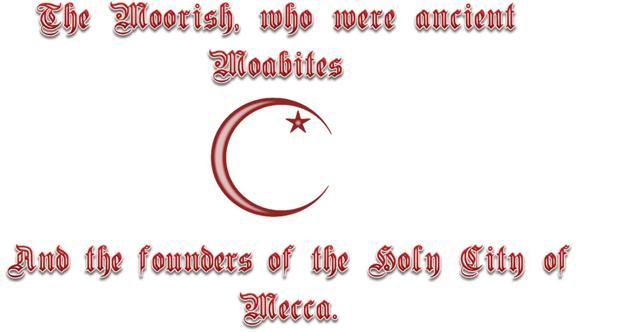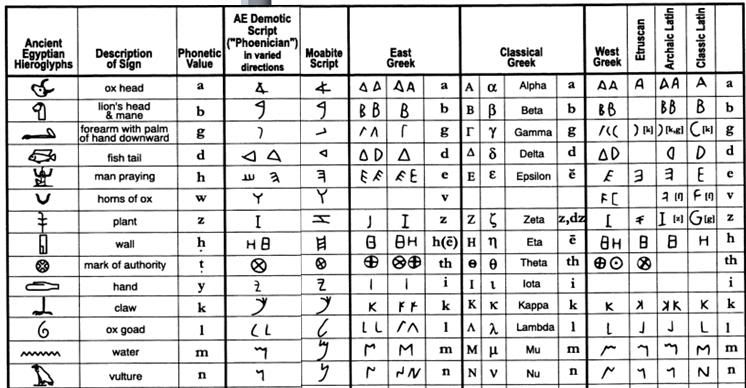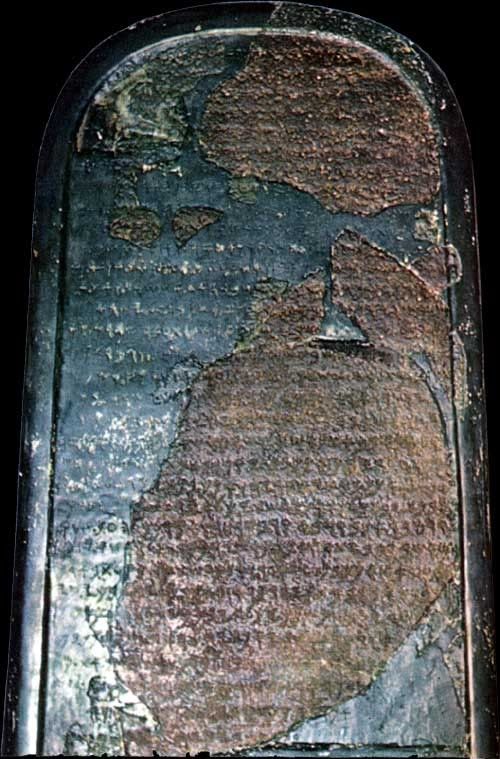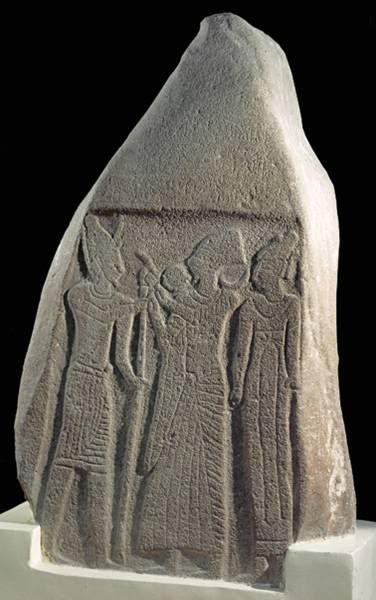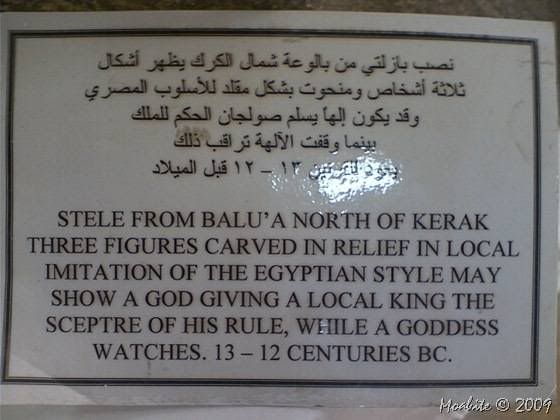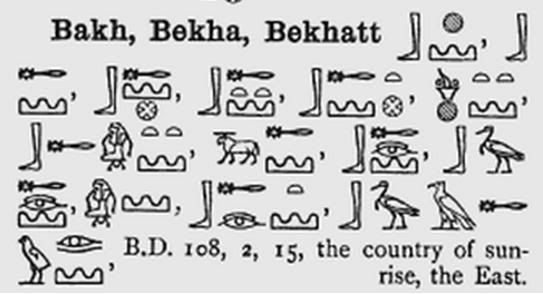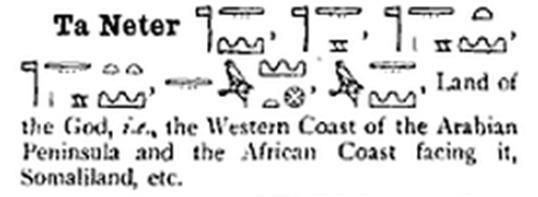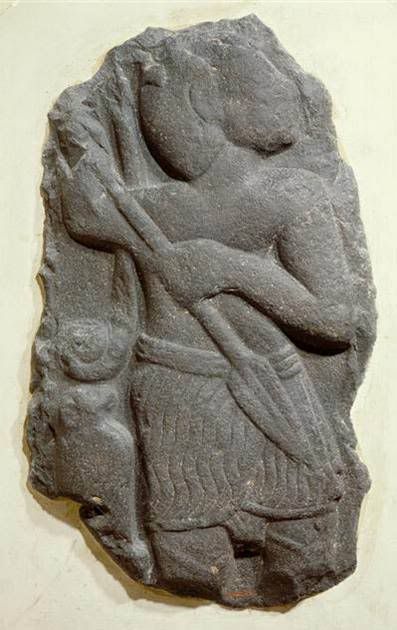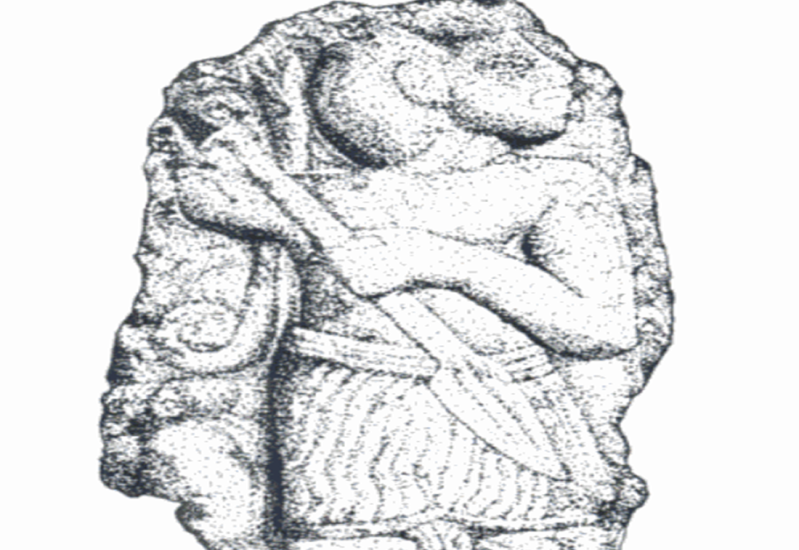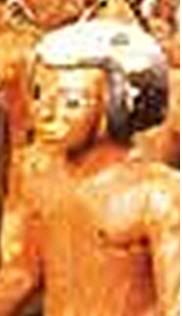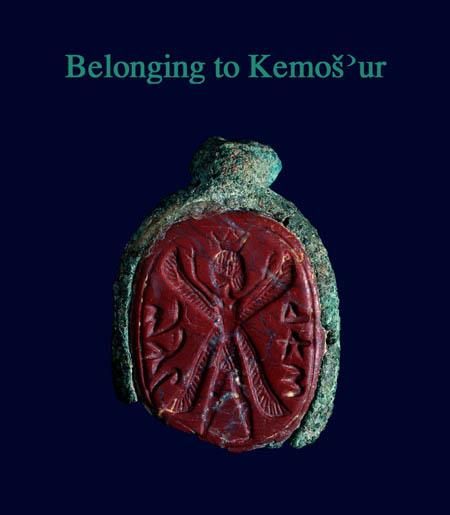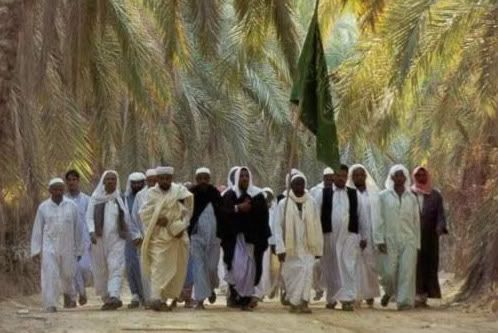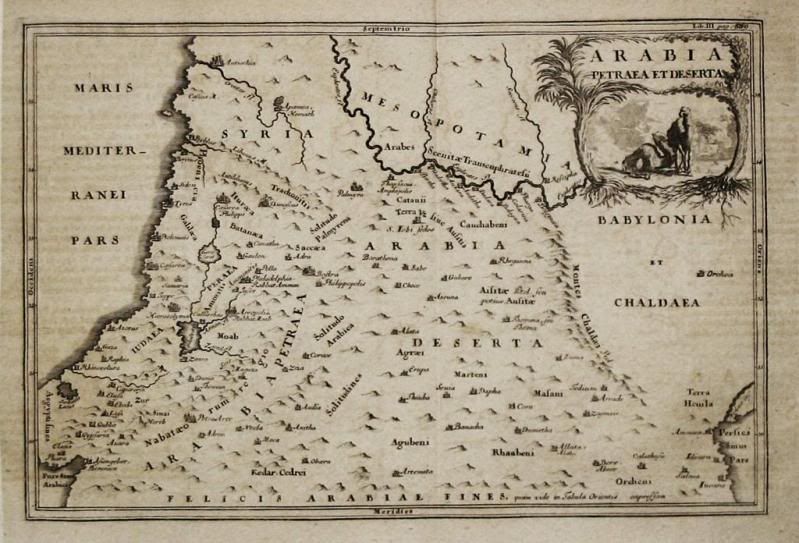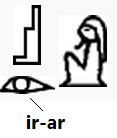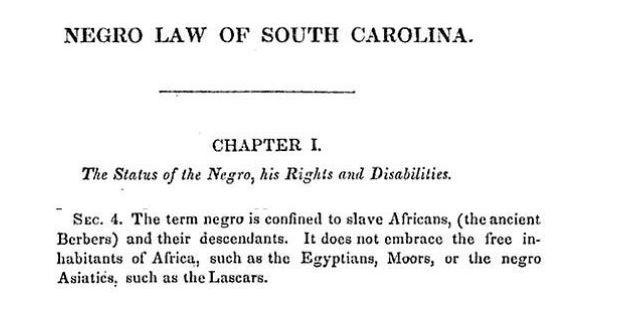THE LOST TRIBE OF SABAS (SHABAZZ). RECONCILING THE HISTORY, IDENTITY AND ORIGIN OF THE ANCIENT MOORISH TRIBE.
Islam and greetings to you all. I rise giving all praise to Allah and the highest of honors to his Holy Prophet Noble Drew Ali. I extend those honors to the harbinger and forerunner whom I personally call “St. Garvey Bey” Marcus M. Garvey. I extend honors to all true and divine Prophets and I extend honors to you all for when man honors man, he honors his father God-Allah. In this dissertation, we will attempt to trace the origins of the Lost Tribe of Shabazz of Nation of Islam lore to none other than the ancient Sabeans. Trying to track down such a tribe where there is no other evidence insofar as linguistics is concerned, is a difficult task. Myself, being born a 5%er and having the same accounts deriving from the Nation of Islam, have never been able to prove the existence of such a tribe and when I read “plus degrees” and other NOI exegesis concerning the lost tribe as I got older in life, they could not be reconciled with any tangible information that any true scholar would respect. This has prompted us to look deeper into the legend and the location where they held dominion according to the claims made by Elijah Muhammad and we have come to the conclusion that the very name Shabazz is merely a phonetic rendering of the name Sabas which is in fact Sheba with Sabas being a more truer rendering than the name Sabean that we have in our vernacular today.
I want to first present you with several citations of Elijah Muhammad, the originator of the legend of the said tribe from his book Message to the Black man in America:
“Who is better knowing of who we are than God, Himself? He has declared that we are descendants of the Asian Black Nation and the tribe of Shabazz. You might ask, who is this tribe of Shabazz? Originally, they were the tribe that came with the earth (or this part) 66 trillion years ago when a great explosion on our planet divided it into two parts. One we call earth and the other moon.”
“We, the tribe of Shabazz, says Allah (God), were the first to discover the best part of our planet to live on. The rich Nile Valley of Egypt and the present seat of the Holy City, Mecca, Arabia.”[1]***NOTE: We have only the ebook so the actual page numbers appear off as they are not listed on the pages on said ebook so if we are off in our quotes then we stand to be corrected.***
Being that it is hard to impossible to place a 66 trillion year existence on the planet earth or even the entire universe, and attaching such an exorbitant amount of time to the planet earth and connecting it with a people, made any true researcher analyzing the account, view it as unsubstantiated myth and summarily dismissed it outright. Being that Elijah Muhammad located this tribe in Arabia and also along the Nile, then it became easier for me as a researcher to eliminate the 66 trillion year portion of this equation and focus on the people, and finally put the pieces to this puzzle together which has also been a part of my childhood and my studies while growing up.
As I have mentioned above, there is only one ancient tribe that we can connect this name phonetically with and that is the Sabas. The name Shabazz, as it is clear, is plainly an English vernacular rendition of Sabas which means that "Shabazz" was not the name of the Tribe(s) in its vernacular, but it was merely the place that they descended from which we find historically called 'Sabas' in ancient Arabia. If you were to listen to the audios and videos of Elijah Muhammad, then you will hear his pronunciation of the word Koran. He pronounced it “Kowaan” and after doing this research, I am now convinced that the name Sabas, was also pronounced phonetically by Elijah Muhammad as Shabazz and thus, this form of the name stuck, spelling and all. This is called “deductive reasoning.”
Most early scholars note that most African authors say that the first inhabitants of the eastern deserts of Berberia and Numidia, called African Berbers, were five peoples of Sabas who came with Melec Ifriqui, king of south Arabia, from whom was taken the name 'Africa'. These people still maintain that their ancient names were Zinhagia, Alucamuda, Zeneta, Haoara and Gumera. From them descend six hundred heritages of African Berbers, and from them come all the noblest kings of all Africa, such as Ibn Al Raquiq, in the book of the Tree of African Lineage.[2]
These five peoples first populated eastern Berberia, and afterward spilled over into different habitations, making themselves lords of most of Africa. They were collectively called African Berbers, because they first lived in Berberia.[3]
As I have chronicled in my video ANCIENT CANAANITES PT. 2: The Moabites; Moor and Berber are simply synonymous terms with each other and these very people that lived along the Nile in ancient times, these same Moors are also called Sabas as has been noted above, to which I will further chronicle later in this treatise, and who too were called Berbers. The old ancient Roman Periplus map of the Arabian sea proves that these Berbers were in fact living along the Nile and in East Africa, the very place where the Moors first crossed over into when they migrated from Arabia into Africa. Djehutmuse I of the 18th dynasty supposedly listed the Barbara as one of over 113 tribes that he conquered and also mentioned in the time of Ramses as Beraberata. The early name of this population appears to have been Nobatae or Noubai and the name may have been related to that of Napatans.[4]
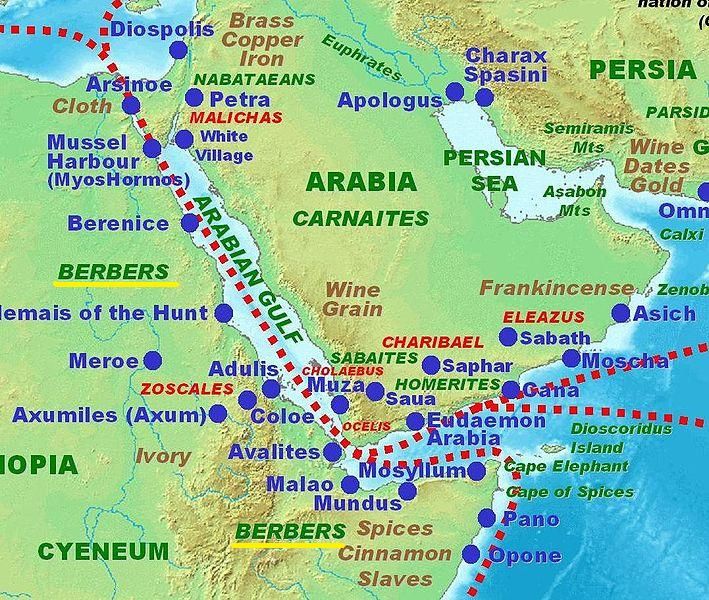
Prophet Noble Drew Ali informs us in Act six of the Divine Constitution and By-Laws of the Moorish Science Temple of America that the Moorish Americans, meaning our people who live on this land in the United States of America and who identify with the misnomer “black” are descendants of the ancient Moabites whom inhabited the Northwestern and Southwestern shores of Africa. These are no doubt the sons of ancient Canaan as has been chronicled by many early historians and hitherto concealed by many modern ones.
In studies of the peoples of West Africa, it is noted that the Benin people are descendants of the Yoruba tribes and that the Yoruba tribes themselves are descendants of six brothers, all sons of one mother. Their names were Ikelu, Egba, Ijebu, Ifé, Inbni (Benin), and Yoruba. According to a west African Sultan named Bello, as chronicled by Hugh Clapperton (1788 –1827) a Scottish traveler and explorer of West and Central Africa, the Yoruba tribes are descended from the children of Canaan, who were of the tribe of Nimrod.[5]
Conversely, in East Africa, according to early sources that cite eastern legends of the Habesha (Abyssinians), it is stated the Cush is in fact a son of Canaan and that these Cushites called eponymously "Cush" had a son named Habesha whose name derives from Hebrew grammarians meaning a raised mixture of different countries (Osborne, 1748 pg. 254). When viewing the location of the map above, it is no doubt that these people were anciently seen as Barabras or Berbers, an ancient race name predating Nubia/Nuba, a name given to denote a slave or servant.
Some 5%er and Nation of Islam lore, not all, also says that Shabazz was called “Grand Daddy Shabazz” who is said to have taken our people into the jungles of Africa 50,000 years ago. In this, Shabazz is made into an eponymous character like has been done with many of the characters in scriptures. We reason this out because if Shabazz was the name of this one man, and the people are called collectively the “tribe of Shabazz” by the Nation of Islam, then it is evident that Shabazz is eponymous in the same way Moorish Americans say Old man Cush and his father Ham and it attribute these names to a father and his son, but history proves it simply to be the location name of our peoples in the most ancient of times.
In research, analyzing every word is vitally critical. Notice that Elijah Muhammad said that this tribe “chose” for themselves Arabia and the Nile region. This means that one can correctly speculate that this tribe did come from somewhere else to establish civilization in these parts and from whence they came is undoubtedly, based on what has been presented and what will be in this exposition, from the ancient land of Canaan as was revealed by our Holy Prophet Noble Drew Ali. Being that we can place this time in remote antiquity based on the teachings of Elijah Muhammad, dating back to 50,000 years, this brings us to a source you have seen me cite often from Godfrey Higgin's Anacalypsis when he states:
“It was the opinion of Sir William Jones, that a great nation of Blacks formerly possessed the dominion of Asia, and held the seat of empire at Sidon [the capital city of Canaan]. These must have been the people called by Mr. Maurice Cushites or Cuthites, described in Genesis; and the opinion that they were Blacks is corroborated by the translators of the Pentateuch, called the Seventy, constantly rendering the word Cush by Ethiopia. It is very certain that, if the opinion be well founded, we must go for the time when this empire flourished to a period anterior to all our regular histories. It can only be known to have existed from accidental circumstances, which have escaped amidst the ruins of empires and the wrecks of time. Of this nation we have no account; but it must have flourished after the deluge. And, as our regular chronological systems fill up the time between the flood and what is called known undoubted history; if it be allowed to have existed, its existence will of course prove that no dependance can be placed on the parts of that history. It will shew that all the early chronology is false; for the story of this empire is not told. It is certain that its existence can only be known from insulated circumstances, collected from various quarters, and combining to establish the fact. But if I succeed in collecting a sufficient number to carry conviction to an impartial mind, the empire must be allowed to have existed”[6] [added emphasis mines]So here we can evidently confirm by these early archaeologists, that the seat of the rule of all of Asia, this would probably include the Nile region of Africa on eastward, was held in the ancient land of Canaan at a time period that they simply could not put a number or figure on. Prophet Noble Drew Ali would constantly use the term “Ancient Canaan” as to distinguish it from a time when we ruled, and the time that we were pushed out by Joshua. We would have absolutely established civilization, great cities, and large bands of Nomads all throughout Africa and Arabia which is situated true south of ancient Canaan if, we are saying that Canaan was represented how it is accepted by biblical scholars today.

Sabas who is also noted as biblical Sheba, was a kingdom in pre-Mohammaden southwestern Arabia, frequently mentioned in the Bible (notably in the story of King Solomon and the Queen of Sheba) and variously cited by ancient Assyrian, Greek, and Roman writers from about the 8th century BC to about the 5th century AD. Its capital, at least in the middle period, was Maʾrib, which lies 75 miles (120 km) east of present-day Sanaa, in Yemen. A second major city was Ṣirwāḥ. [7]
This same Sabas is Seba or more intimately, Sheba of ancient fame and if we look at the biblical chronology, such names like it are directly connected to each other through the generations. In this, we can see the ‘S’ transform into ‘SH’ and vice versa as was done in many names that start with ‘S’ like Sabbath as we say it, which is said as Shabbath in what is known as the Hebrew tongue. According to Smith’s Bible Dictionary 1966-77, we read for Seba and Sheba which are listed separate with Seba being the son of Cush and Sheba being the grandson (possibly noting a shift in pronunciation) as given in the same exact biblical verse proving both are the same patronymic eponym but listing Sheba as a son of Raamah which is probably no person at all as the name Raamah is said to mean “trembling” by the descendants of Joshua (so called Jews) who in their Torah, gave pejorative definitions to the named people of Canaan and Cush that is copied into their bible. This bible dictionary reads:
SE’BA. First son of Cush (Gen. x. 7). A nation in Africa included Cush, and having a name and power in Solomon’s time (Ps. lxxii. 10). Located in the island Meroe, which lies at the injunction of the white and blue branches of the Nile. The chief city (Meroe) had an oracle of Jupiter Ammon (or the ram-headed Num), ruins of which are now visible besides pyramids, and other indications of a great population. The great stature and beauty of this people was a theme of the ancients (Herod iii. 20, 114; Is. xliii. 3, xlv. 14; Ez. xxiii. 42). See Josephus, A. J. ii. 10, 2.
She’ba (red), (Gen x. 7) 1. Grandson of Cush; 2. Tenth son of Joktan (ver, 28); 3. Grandson of Keturah (xxx. 3). 1. The name of the kingdom of South Arabia, before Himyer took its place, a few years before Christ (24–Strabo). Here were the Sabæans of Diodorus (iii. 38, 46). A queen of Sheba visited Solomon (1 K. x.), attended by a great train, camels loaded with spices, gold, and precious stones. The chief cities were Seba, Uzal (now Sana), Sephar (now Zafar), and Mariaba (now Marib). This district had the chief riches, best country, and greates numbers of all the four peoples of Arabia. The local history is authentic only as far back as the first century A.D. There ancient religion was pagan. – 2. Settled on the Persian Gulf. On the island of Bahreyn, in the Gulf, are the ruins of an ancient city called Seba. Its merchants are mentioned in Ezekiel xxvii. 23.–3. The sons of Keturah are charged by Job (i.15, vi. 19) with the robber habits that are peculiar to the Bedawin of our day.So here we place the ancient Sabas in Meroe which is the southern portion of the “two lands” of Egypt and we know from studying the works of many early scholars, that Cush does not start in Africa, but starts in Arabia and India before it establishes the kingdom noted in the bible as Sheba which becomes Axum and modern day "Ethiopia". So in this, we understand that Sabas is merely a descendant nation of Cushites whom Prophet Noble Drew Ali said came from the ancient land of Canaan and were the first to occupy the land we know today as Africa.[8] This reconciles what Elijah Muhammad said above when he placed Shabazz within “The rich Nile Valley of Egypt and the present seat of the Holy City, Mecca, Arabia.”
Noble Drew Ali informs us also that it was the Moabites who founded the Holy City of Mecca.[9] I have done research into this very account and have given a preponderance of the evidence that in all inference, gives verity to the claim made by our Prophet Noble Drew Ali. You can read that particular thesis here:
http://lordabba.blogspot.com/2013/04/the-moorish-who-were-ancient-moabites.html
What we also notice is the cities listed in their original appellation cited as “Seba”, “Uzal”, “Zafar” and “Mariaba.” Mariaba is said to be Marib. In the same book, it defines Arabia and it says that the city of Marib is so ancient, so remote, that it was in ruins by the time Solomon came to reign(pg. 21). Its original appellation struck me interesting. It appears in my opinion as a compound of two words, that being Mari – Aba. I will have more on this latter in this presentation.
Now, Prophet Noble Drew Ali who was the first to give us the information on our people founding civilization in Arabia, states that the Holy City of Mecca was in the ancient land of Canaan.[10] In a personal correspondence with renowned scholar and archaeologists who wrote the ethnohistory of the Moors in the Book Golden Age of the Moor by Ivan Van Sertima, after giving her the excerpts of our Moorish Holy Koran (also called the Circle 7 Koran) had this to say concerning such:
“I am not sure who Noble Drew is but he seems to have known through some other esoteric oral means much of what I had also come to realize. Many ancient and medieval writers like Procopius also claimed the Canaanite peoples took over the North African area and settled in places like the Balaeric Islands as well. Of course there is also evidence certain Moorish individuals made it to America. It is my belief the original Canaan in Afro-Asiatic tradition is in the area south of Mecca stretching into the Asir Tihama and Yemen. They left there first as Moabites (named from chief Mu'awia), Hamathite (Hamadi), Madianites, Amalek (Melukhha the modern Amluch), Hittites (named from Hadah or Heth, now knwon Hada'Ndawa), and moved north into Syria and East Africa probably in the Hyksos time period. Many people don't know these are the names of African-looking people still living in the area of Yemen and in areas across the red sea in Africa. Of course Canaanites are called black in almost all references including those of Syrians and other Arabized peoples - including Ibn Khaldun, Al Dimasqi, Masudi, and numerous writers refer to the Berbers as being black because of their Canaanite origins.”So not only does she give her scholastic opinion, she also cites many early Islamic scholars who said the same exact thing. Some of these sources I have reviewed myself which lead me to believe that the Aryanization of Islam has at its roots, this Canaanite origin of the Moorish people and why they, the Moors of Islam, were treated in the same manner that Christian Europeans treated our people all for the purpose of concealing these facts. Of course, this is my honest opinion. In Mosques in Algiers however, many people of Moorish descent who still identify themselves as being of Moabite (Mozabite) descent, are not allowed into the Mosques[11] although no such provisions are mentioned in the Koran of Mecca, it gives us a glimpse at how the original message of Prophet Mohammad was corrupted and the obnoxious elements of Christian European racism was adopted by the fairer skinned people of Al-Islam.
Early scholars of the 1700’s spoke of the Sabas in what we know now today as Ethiopia and specifically noting that Sabas was also the ancient name of Meroe[12] which unequivocally intimates that the people of Meroe were viewed as the same exact people called the Sabas or Sabeans. They have detailed that there was in fact another Sabas near Adulis on the Arabian Gulf, answering to the Sabas of Arabia with the Gulf lying between them so that the two Sabas that are mentioned in Psalms 72:10 are made to correspond where it says “The kings of Tarshish and of the isles shall bring presents: the kings of Sheba and Seba shall offer gifts.”
Another early source I came across dating back to the late 1800’s called The historical geography of Arabia, in a chapter entitled SABÆI AND HOMERITÆ: SABATHA METROPOLIS: SABBAR METROPOLIS, we read:
“According to native authorities, the once famous kingdom of the Sabeans of Yemen… whose capital Sabas (agreeably to a known Arab usage) we learn from Agatharchides, gave name to, or rather received its name from, this illustrious people,… at a period seemingly long prior to our era, had yielded its supremacy to that of the Homerites: a race of conquerors from the north of the peninsula, whose commercial settlements we have already traced along the southern coast. Accordingly, in the age of Arrian, we find the two people united under the one king; a Homerite prince, whose seat of government was at Aphar. The respective positions of their capitals will best enable us to discriminate between the two nations.”[13][emphasis added mines]We could possibly surmise that these “race of conquerors from the north of the peninsula” could be the people of Canaan, specifically the Moabites who lived in what the Romans called Arabia Deserta” and who correspond to sources that say that the very language of the Moabites which was called the Mudar langauge, the language of the Bani Quraish from whence Prophet Mohammad was born, the very same language that the Koran was revealed in (and not the Arabic as we were misled into believing) is said to have come form the north.[14] You will find that in the note that I have posted above as well. In the next chapter, SABAS, OR SABATHA METROPOLIS., we read:
“The Sabas of Abatharchides is obviously the same with the Sabatha of Ptolemy and Arrian; a chief city of the interior, seated on a hill, situated due north of Kanè emporium, in lat. 16˚20’. The site, the longitude, the latitude, all concur in identifying this metropolis with the Mâreb of the Arabs; which stands upon a hill, amids an amphitheatre of mountains, due north of Hussan Ghoráb (the ancient Kanè), in about lat. 15˚50’ according to d’Anvill. In Mâreb, we have the metropolis of the Kingdom and people of the Sabeans.”[15] [added emphasis mines]There is a reason that I place bold emphasis on the quote that says "which stands upon a hill" I will briefly touch on this forthcoming. This now brings us back to this interesting name of Mar’ib, said to be earlier called Mariaba. This researcher has not found any etymological trace for the name Mar’ib or Mariaba. So in this, I offer my hypothesis on the said name being that it phonetically sounds like the original name of Morocco which was founded by the descendants of ancient Mo’ab i.e. the Moors.
In a journal published in Great Britain and Ireland in 1885 by the Royal Anthropological Institute, it posited the geographical locations and peoples who lived in these regions from Arabia and Africa as a people who correspond with each other. What was interesting was what I came across on page 114 of their journal that states:
“The Jalin claim special consideration as the most numerous, intelligent, and purest of all the Sudanese Arabs. They trace their descent from Abbas, uncle of the Prophet; but their Arabic speech, preserved and spoken with great purity, indicates Hejas as their original home. The chief Jali tribes as enumerated by Munziger, are: Muhammadab, Mikringa, Bagelab, Uâdieh, Gebâlab, Kaliab, Meirefab, Mosellemab, Omarab, Timerab, Kitejab, Giaberab, Aliab, Giuberab, Seidab, Shainab, Megiadab. The final ab of these tribal names is not Arabic, but a Beja patronymic ending, borrowed from the neighbouring Hadendoahs of the Mareb Valley, with whom they have long been intimately associated.”[16] [added emphasis mines]Firstly, the Jalin or the Jahalin are the inhabitants of the Blue Nile confluence; the Khartoum district who are traders and settlers in the regions of Senaar, Taka, Kordofan, Darfur, and Kaffa. Let us now reveal the identity of Prophet Mohammad’s uncle Abbas. An important Moorish scholar of ninth century Baghdad, noted in his Fakhr al-sūdān alā al-bidan “The Boast of the Blacks over the Whites” that:
“The ten lordly sons of ‘Abd al-Muttalib were deep black (dalham) in color and big/tall (dukhm). When Amir b. al-Tufayl saw them circumambulating (the Ka’ba) like dark camels, he said, “With such men as these is the custody of the Ka’ba preserved.” Abd Allah b. Abbas was very black and tall. Those of Abu Talib’s family, who are the most noble of men, are more or less black (såd).[17]This account is important because it gives to the racial identity of the family of Prophet Mohammad (although this early Islamic scholar is using the terminology “black” picked up by the Europeans in describing peoples of Moorish descent), because it details that ‘Abd al-Muttalib and his ten sons were full blooded Moors and pure Arabs with ‘Abd al-Muttalib being the paternal grandfather of the Prophet Mohammad.[18] There are so many sources that correspond to the racial identity of Prophet Mohammad and his closest relatives that for this treatise, it would be redundant to list them all here. Seek out the scholastic works of Dr. Wesley Muhammad, Phd., who has done critical research in this field for deeper analysis of this specific topic.
Now we get to the suffix ‘–ab’ which is ironically found in the name that Moslems of the Moorish Science Temple of America claim in Mo’ab that we have from the ancients. In doing research into the Moabites whom were irrefutably the Moors who went to conquer Spain and whom inhabited the Northwestern and Southwestern shores of Africa, I came across an interesting source which listed the actual name of Morocco in its glossary. I have captured a screenshot of this rare book to give to the reader a visual reference of the text and the footnotes it corresponds with.

And we find in the glossary what is known as the list of proper names in the very same book that Marab is the original name for Morocco.[19] It is clear that Marocc or Marak is the French derivation of what we have in the English today as Morocco. This very book is based on the Matter of France and their dealings with Charlemagne,[20] founder of the Carolingian Empire, which began 768 A.D.
As I have hypothesized before in my videos and blogs, when we see the name Mo’ab or Mo’av as it is written in the biblical Hebraic sense, the apostrophe (’) in the middle of Mo and ab appears to serve as a phoneme. A phoneme is the smallest possible sound in a word. For instance, if you take the ‘e’ of fishes to represent the second vowel phoneme of that word, then you can hear that in fish's the apostrophe represents that same vowel phoneme sound 'e'. Ironically enough, when you add an apostrophe at the end of English names, the resulting sound is a ‘Z’ sound which adds to my theory on why we get the name Shabazz from Sabas. This is what you get with Mo’ab. It can then logically be written like this Mo[R]ab and is undoubtedly why we get the name of the Moors in North Africa of Spain mentioned as the Morabites and Almoravids.
This then leads me to the Beja language to find the exact meaning of what this word ab defines. According to one Beja language dictionary that was compiled by sociolinguist R. A. Hudson, who is a professor of linguistics at the University College of London, we find the meaning to the Beja meaning of the name ‘ab’.
He lists in his dictionary on the Beja language that ab and abḁ means “kid” and if I am reading it correctly, aba is plural of ab.[21] Now, when we look at the ancient name of Mareb/Ma’rib or more properly as “Mariaba”, we can infer that this name is a compound word with the MARI and the ABA being two separate words compounded to form one. It is quite possible, just based off the Beja meaning of the word ab, that aba in this instance, means “children of” and that Mari, as I have noted in my video titled “ARE ALL SO CALLED BLACK PEOPLE MOORS” is the ancient name of the mystical place of descent of our people.
As cited in this note, and many other sources that I have listed elsewhere, the very origin of our ancestors, these Moors, are said to be based on ancient myths much like the tribe of Shabazz. For instance, the Roman historian Gaius Sallustius Crispus, who is known more by his anglicised name as Sallust (86 BC – c. 35 BC) maintained that the Moors were a “remnant of the army of Hercules” [22] which gives us insight into how the Greeks actually saw the Moor as strong and fierce warriors, descendants of a God.
We find the name Moor, in reference to whom the Greeks called “Ethiopians” mentioned in ancient records of the Chaldeans (Babylonians) under the name “Mirukh.”[23] The Hindus knew our ancient fathers by the name “Meru.”[24] The Greeks knew our ancient ancestors as the Meropes.[25] And the Egyptians, recorded themselves as TA-MER-AU[26] with the "Ta" meaning "land of" and the “au” denoting plurality as in the name of the people collectively leaving us then with "MER."

We can safely assume that the “-ukh” in Mirukh, the “-u” in Meru and the “-opes” in Meropes, also linguistically represents plurality. All of these names are centered on a people issued form a mountain or a man-made mountain, i.e. pyramid. The Greeks say that the Meropes were the first men issued from a place of the same name. The Hindu say the same exact thing about the men of Meru and early scholars have intimated that all of these different variations of these, our ancestors, are one and the same, including Meroe of Cushite fame[27], which was founded by our Cushitic ancestors in the 25th dynasty Africa though it had its roots in the Asiatic nations. Godfrey Higgins in his Anacalypsis not only speaks of the origin of man as Mount Meru, but he specifically cites the Sabeans as the people who descend from this sacred Mount. From page 354 we read:
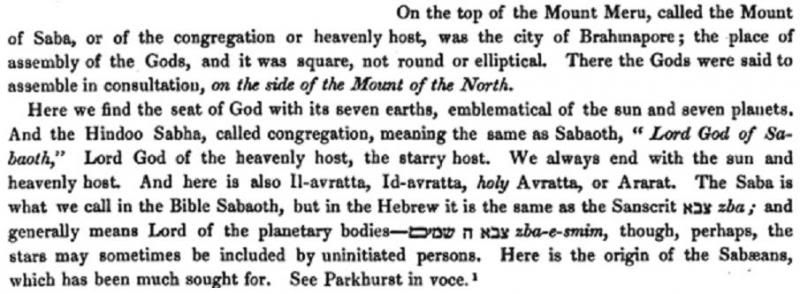
Godfrey Higgins seems to confirm definitively in the above based on a source he obviously reviewed and cited that the Sabeans were in fact the people descended from this sacred Mount. This theme with some sort of mountain can be found everywhere. When the Moors conquered Spain for instance, they captured a town at the foot of the Esparteros mountain and renamed it “Moron”.[28] We find in all of these ancient dwelling places of the Moors who would later come to be known as the Sabas, that there is some city of their dominion with this /mir/mor/mar/mer name attached to it and most of the time, it is associated with a high place like ancient Mareb (Ma’rib/Mariaba) which was anciently situated upon a hill. When confronted with these names, Eurocentric historians tried to play down these places containing these names by saying that these names had no real ethnical value and the backdrop to this is because it is all shrouded in a mystery that European scholars just have not been able to crack or refused to reveal. Again, I will go more in-depth on this in my book on this topic.
In an 1841 works titled History of the Moors of Spain by an author simply known as “Florian” , we find the most interesting account in that, as noted previously in this work, speaks to this “mythical” and ambiguous origin of the Moors that Godfrey Higgins with confidence concluded. It reads:
“The origin of the Moors, or Mauritanians, is like that of most other ancient nations, obscure, and in the information we possess concerning their history confusedly mingled with fables. The fact, however, appears to be established, that Asiatic emigrations were, from the earliest times, made into Africa. In addition to this, the historians of remote ages, speak of a certain Meleck Yafrick, king of Arabia Felix, who conducted a people called Sabæi into Libya [Libya is anciently the Northern portions of Africa], made himself master of that country, established his followers there, and gave it the name of Africa. It is from these Sabians or Sabæi that the principle Moorish tribes pretend to trace their descent. The derivation of the name Moors is also supposed, in some degree, to confirm the impression that they came originally from Asia [Meru was anciently situated in Asia]. But, without enlarging upon these ancient statements, let it suffice to say, that nearly certain ground exists for the belief that the original Moors were Arabians. In confirmation of this impression, we find that, during every period of the existence of their race, the descendants of the primitive inhabitants of Mauritania have, like the Arabs, been divided into distinct tribes, and, like them, have pursued a wild wandering mode of existence.”[29] [added emphasis mines]The Moslem historiographer and historian Ibn Khaldun (1332 AD/732 AH – 1406 AD/808 AH) who has been deemed as a biased and racist Islamic scholar by some critics of his works, including myself, gave his own interpretation, obviously borrowing from the biblical accounts and the diffusion of Euro-occidental thought with Islamic scholarship, as to the reason why the Moors or Berbers were dark complexioned. He writes:
“Ham, having become black because of a curse pronounced against him by his father, fled to the Maghrib to hide in shame.... Berber, son of Kesloudjim [Casluhim], one of his descendants, left numerous posterity in the Maghrib”[30]Such a myth as has been espoused may be the source as to why it is popularly believed that Ham was the recipient of this curse and not Canaan whom the bible falsely lists as having been cursed by Noah. In doing this research alone, I have come across many early works who uses Khalduns works to identify just exactly who the Hamites were. I will expand these sources in the book. The very fact that Ibn Khaldun called our people “blacks” proves this because this stigma of Euro-concocted black or negro race is attached to our people up until this day. Such practices have been accepted by Moslems of fairer complexions to this day and is the reason why in certain Mosques in the Islamic world as I have noted above, because of our Moabite origin, are rejected from entering Mosques for worship. So we can understand why Prophet Noble Drew Ali not only brought to us our true and divine religion of Islam, to which he called that “old time religion” we also see why Elijah Muhammad himself took this model as well and extended a more refined modernized or Americanized version of Islam to our people. He himself was quoted as saying:
"I have always had a very high opinion of both the late Noble Drew Ali and Marcus Garvey and admired their courage in helping our people (the so called negroes) and appreciate their work. Both of these men were fine Muslims. The followers of Noble Drew Ali and Marcus Garvey should now follow me and co-operate with us in our work because we are only trying to finish up what those before us started. In Islam alone shall we find the success we desire.”[32]To continue, there are so many sources that wholly agree with what Prophet Noble Drew Ali informed us of when speaking of the Canaanite origins of those who would come to inhabit Africa:
“There were four sons of Ham, from whom sprang following nations. Cush, from whom the Ethiopians were begotten. Mesraim (i.e. Egypt), from whom the Egyptians are said to have risen. Put, from whom the Libyans – whence the river of Mauretania is called Put still today, and the whole region around it is called Puthensis. Finally Canaan, from whom descended the Africans and the Phoenicians and the ten tribes of Canaanites.”[33]This leads us to the most interesting of legends concerning the three Wise Men of what can be called “biblical fame”, but as we shall undoubtedly see, is of no biblical mythos whatsoever. One should note that, everything copied into the bible, does not have its origins there.
Prophet Noble Drew Ali informs us in the Holy Koran of the Moorish Science Temple of America (also known as the Circle Seven Koran) of the national and Moorish descent origin of Prophet Jesus. He informs us that “Jesus himself was of the true blood of the ancient Canaanites and Moabites and the inhabitants of Africa.”[34] These Canaanites and Moabites would have unequivocally been the same exact people that is spoken of as having their origins in ancient Arabia which I have no doubt was a part of ancient Canaan.
One of the accounts surrounding Prophet Jesus is shrouded in equal mythic mysticism as the origin of the Moors themselves and it concerns the “fabled” Three Wise Men also called the Magi. In the same book mentioned above detailing the historical geography of Arabia, an interesting passage caught my attention pertaining to the Magi which connected like a jigsaw puzzle to the information that I have just come across recently as I researched for this tract. It says this:
“THE Magi – The tradition of the church, and opinion of the learned, with nearly one voice, lead us to seek in Arabia the seat of these eastern sages. Justin Martyr, Tertullian, St. Cyprian, Epiphanius, among the ancients, Baronius, Lightfoot, Ussher, Grotius, among the moderns, sufficiently represent the consenting judgment of fathers and commentators, upon this interesting topic. This general consent is trebly justified, 1. by the authority of the prophetic Scriptures, which bring the kings of Arabia, to offer its peculiar products, at the feet of the infant Messiah; 2. by the position of the Arabian peninsula, which is commonly described, in the Old Testament, as lying to the east of Jerusalem and Palestine; and, 3. by the joint testimony of Pliny and Ptolemy, who speak of Arabia as a seat or school of Magi; the very title which Saint Matthew designates the wise men in the Gospel.”[35]
“to Epiphanius, or rather to an ancient tradition preserved by him, the Magi, or wise men of the Gospel, were of the family of Keturah. Morden (who wrote in the seventeenth century), in his General Geography, with apparent allusion to this tradition, makes these eastern Magi natives of Sabe, or Sabeansof the neighborhood of the Euprhates.”[36][emphasis mines]Notice the mention of Keturah (incense). According to their biblical accounts, she is the 3rd wife of Abraham who is called the patriarch of a specific biblical line. She is almost never mentioned in scriptures and the only way we find the true meaning of this eponym is through her eponymous sons. The sons of Keturah by Abraham are; Jokshan (fowler?), Zimran (sung), Medan (strife), Shuah (pit, also listed as a descendant of Judah), Ishbak (leaving), and Midian (strife). All of these are dark brown skinned Moors of Arabia and what you notice is that Midian and Medan are said to mean strife which shows us that these are the same people and probably represent different locations at differing times given these pejorative names by the so called Jews who wrote these scriptures and altered names and meanings. The very fact that the Joshuaites (Hebrew writers) gives them the name strife proves this and also, as I have noted earlier, proves that these were Canaanite tribes because they always gave pejorative meanings for the Moors of ancient Canaan. The Midianites and the Moabites share a close affinity in the Europeans bible[37] which means in all actuality, they were anciently connected and probably of the same stock just occupying different regions.
What we are witnessing in the quote above is first and foremost these three wise men or Magi come from ancient Arabia, more specifically, by some accounts, in the neighborhood of the Euprhates. In the Europeans bible, the Moabites in the form of Abraham (father of multitudes) came into Canaan, came to this specific region to which the Romans designated Arabia Deserta, and settled. I have cross referenced several different pieces of information to which most early scholars have agreed to the source above in that these Magi did in fact come from ancient Arabia. I also implore all to research every aspect of this note so that you may see for yourselves what I have come to uncover in tracing our true descent.
In order to understand the intrigue behind these three wise men, we must look to Europe for our answer. The very name of these three wise men are as followed:
King Melchior
King Kaspar
King Balthazar
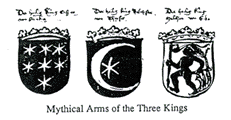
The coat of arms of King Melchoir is a field of seven stars. These would be no doubt connected to the ancient seven planetary system to which we Moorish American Moslems call the Seven Eyes of Allah. The coat of arms of Kaspar bears the crescent Moon and star . It was Prophet Noble Drew Ali who first brought this symbol to the U.S. and said it is the symbol of our ancient ancestors and the seal of the Prophets. I have shown on many occasions that the Moabites would use the crescent moon and star in combo on their official name seals dating back at least to 13th century B.C. proving the antiquity of this particular motif (Keel, Uehlinge (1998) pg. 322) and why this particular symbol is used among Moslems mainly in North Africa and not necessarily with the founding of the religion of Al-Islam.. The coat of arms of Balthazar, it is in the image of what the Europeans dubbed the “black-a-Moor.” The Moors are always shown wearing the headband showing a unique connection to the history of the ancient Canaanites to which I highlight in my video on the ancient Canaanites, Moabites and Moors.
The interesting thing about this as well is that there exists another coat of arms for Melchoir which is said to be connected to the Heider family coat of arms, a German family who claims to have lineal descent to this ancient Moorish Magi and is the reason why the Heider coat of arms has the Moor or as they called us the “black-a-moor” emblazoned upon their escutcheons.[38] I will have much to share concerning these finds in upcoming works.
The reason why this aspect is so important, is because it reveals to us the identity of the lost tribe of the Sabas, who were unquestionably situated in the Northwestern and Southwestern shores of Africa, who are the “children of Mari” based on my opinion to which we can conceivably designate as MO’AB and the very name that they gave this land that we know today as Morocco, is MARAB, to where they migrated, and we get Prophet Noble Drew Ali coming back to reveal to us that we are NOT BLACK PEOPLE, NEGROES, or COLORED persons but that WE ARE MOORS who are the ancient Canaanites and Moabites and that he himself, was Prophet Jesus manifest again for these days and times and raised up the lost but now found nation of Moab, who also had the designation of Sabas of which Elijah Muhammad phonetically gave to his flock as Shabazz. So we can now trace the lineal descent of the Moabites or Moors who were later called the Sabas from a city that came to fame in historical chronology and scriptural history (however distorted), to which has shown us that there is always one sent to raise his people back up to the state of God-Men or Allah in Man (Emmanu-El) and it is without a doubt, based on the provable theology espoused by the Moorish American Moslems, thought once to be myth and laughed off as such, the historicity in the doctrine that Prophet Noble Drew Ali has brought to us, which lead to many offspring organizations like the Nation of Islam as Elijah Muhammad admitted that he was carrying on the work of Prophet Noble Drew Ali who did bring Islam to our people in 1913, which produced many political and other Islamic styled organizations, then it is no doubt that the Prophet’s claim of his messiahship, can be traced, rectified, and reconciled with the information that Elijah Muhammad taught to his followers insofar as this particular tribe is concerned.
This concludes this note for now. I had to cut this one short because it is a part of a larger treatise that firstly would not all fit here, and secondly, to see if ones will do any research into this particular note, that which will be under appreciated by an ever flippant audience of men usually too dogmatic and obstinate in their own doublethink, to accept anything outside of what they have heard or believed to be truthful. Those true followers of truth, will see this information for what it is and do their own due diligence into it and find that there is no other way to reconcile the lost tribe of Shabazz particularly if you say that these were real people whom Elijah Muhammad himself has placed in Arabia and upon the Nile. This is my humble service to you all in providing a critical aspect of linking the two ideologies together whether you accept it or not.
Peace, Sheik Way-El
Sources and references
_____________________________
[1] Message to the Black Man in America by Elijah Muhammad
[2] EASTERN BERBERIA, or The East African Roots of the Original Berber Peoples http://afroasiatics.blogspot.com/2012/09/the-eastern-berbera-east-african-roots.html#comment-form
[3] Luis del Marmol Carvajal, 1520A.D. - Spanish traveler and chronicler from Granada. [4] Keane, 1920, p. 73 and see fn. 1
[5] West African Studies By Mary Henrietta Kingsley, Charles Napoléon Cardi (comte de.), John Harford, published 1899 pg. 456
[6] Higgins, Godfrey, Anacalypsis: An attempt to draw aside the viel of the Saitic Isis. Or an inquiry into the origin of languages, nations, and religions, 1836, The Cushites were Arabians, pg. 52
[7] Encyclopedia Britannica http://www.britannica.com/EBchecked/topic/514881/Saba]
[8] Holy Koran of the Moorish Science Temple of America Ch. 47 v. 1
[9] Ibid, Ch. 45 v. 2
[10] Moorish American Questionnaire (101’s) Quest. 53
[11] The Tricolor on the Atlas: or, Algeria and the French conquest By Moritz Wagner, Ferencz Aurelius Pulszky 1854, pg. 198
[12] A Dictionary of Ancient Geography: Explaining the Local Appellations in Sacred Grecian and Roman History, By Alexander MacBean, Samuel Johnson 1773 (no page numbers) [13] The historical geography of Arabia: or the patriarchal evidences of revealed religion By Charles Forster 1844 pp. 273
[14] “As mentioned before, the original home of Arabic – the Arabic of the Qur’ān and of literature – may be traced to the northwestern region of the Arabian Peninsula… The northern region is regarded as the home of the Mudar language, the forerunner of Arabic; and the southern region is considered the locus of the Himyarite language spoken by the Yemenites and their neighbors. This division became more pronounced after the rise and expansion of Islām, when the Mudar language was accorded supreme attributes and superior qualities. Such views were rationalized by pointing to the fact that the Qur’ān was revealed in one of the Mudar dialects, the dialect of the Quraysh tribe.” Arabic Language By Anwar G. Chejne, Chejne, Chejne, pp. 34-35
[15] Forster, pp. 273-274
[16] Journal, Volume 14 By Royal Anthropological Institute of Great Britain and Ireland 1885 pg. 112
[17] Al-JaÈií, Fakhr al-sådan ala al-bidan, in Risa"il Al-JaÈií, 4 vols. (1964/1384) I:209.
[18] al-Dhahabī, Siyar, V:253
[19] Karlamagnús Saga: The Saga of Charlemagne and His Heroes, Volume 2, Part 4 pp 86, 437
[20] The Matter of France. http://www.panix.com/~alexx/orlin.html
[21] A DICTIONARY OF BEJA R.A. Hudson February 10, 2012 http://www.rogerblench.info/Language/Afroasiatic/Cushitic/Beja%20Dictionary.pdf
[22] de. Bell. Jugurth. C. 21
[23] “Wonderful Ethiopians of the Ancient Cushite Empire” Druscilla Dunjee Houston 1926, pg. 127
[24] “Paradise found: the cradle of the human race at the North pole; a study of the prehistoric world” William Fairfield Warren 1885, pg. 236
[25] “Har-Moad: or, The mountain of the assembly. A series of archaeological studies, chiefly from the standpoint of the Cuneiform inscriptions” By Orlando Dana Miller, Stephen Munson Whipple1891, pg. 406
[26] An Egyptian Hieroglyphic Dictionary Vol II: With an Index of English Words, King List, and Geographical List with Indexes, List of Hieroglyphic Characters, Coptic and Semitic Alphabets, Wallace Budge 1920, pg. 815
[27] Willford in Asiatic researches, vol. viii, 1794, pg. 289
[28] Lecture by Iman J. Wilkens to the 'Herodoteans', Classical Society of the University of Cambridge, UK 26th May 1992 http://www.troy-in-england.co.uk/trojan-kings-of-england/trojan-kings-of-england.htm]
[29] History of the Moors of Spain By Florian 1841 pp. 19-20
[30] Smith, 2003. “What happened to the ancient Libyans? Chasing sources across the Sahara from Herodotus to Ibn Khaldun,” Journal of World History 14:4, p. 482 [31] The Tricolor on the Atlas: or, Algeria and the French conquest By Moritz Wagner, Ferencz Aurelius Pulszky pg. 198
[32] The Supreme Wisdom, Volume 2 By Elijah Muhammad, 2008, pg. 84
[33] The Etymologies of Isidore of Seville published 2006 pg. 193
[34] Ch. 46 v. 2
[35] The historical geography of Arabia: or the patriarchal evidences of revealed religion By Charles Forster 1844 pp. 304-305
[36] Ibid, pg. 327
[37] Numbers 25, 31:1-16, 1 Kings 11:7 Solomon built shrines on a hill east of Jerusalem to worship Chemosh the disgusting god of Moab, and Molech the disgusting god of Ammon. 8 In fact, he built a shrine for each of his foreign wives, so all of them could burn incense and offer sacrifices to their own gods.
[38] http://www.hyderhistory.info/Myth_and_Legend.html
Additional sources
An Universal History: The Ancient Part, Volume 18 T. Osborne, (1748)
Gods, Goddesses, And Images of God By Othmar Keel, Christoph Uehlinge (1998)
Books by the author
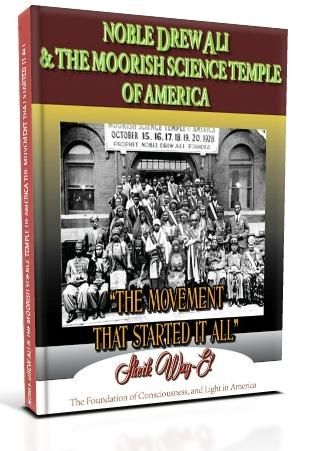

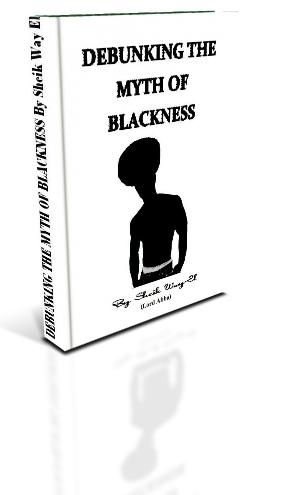

COMING SOON!
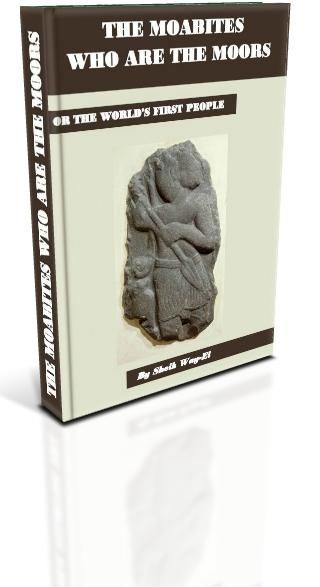
VISIT OUR WEBSITE AT:
www.moorishsciencetemple.org
